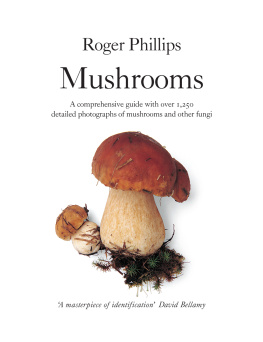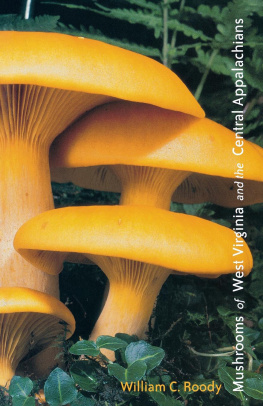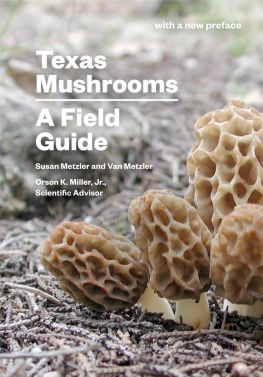

MUSHROOMS
of the SOUTHEAST
Todd F. Elliott and Steven L. Stephenson
TIMBER PRESS FIELD GUIDE
CONTENTS
ACKNOWLEDGMENTS
Many individuals helped to make this book possible, both through the writing process and in the years preceding its publication. We are jointly and especially grateful to a number of individuals for editing taxonomy and providing detailed input on specific groups: Rich Baird, Alan Bessette, Michael Beug, Hal Burdsall, Michael Castellano, Efrn Czares, Cathy Cripps, Roy Halling, Jay Justice, Brian Looney, Roz Lowen, Brandon Matheny, Steve Miller, Kerry ODonnell, Walt Sturgeon, Larissa Vasilyeva, and Rytas Vilgalys. Species lists from forays within our region that assisted with species selection were provided by Charlotte Caplan (Asheville Mushroom Club forays); Patrick Leacock, Glenda ONeal, and Gabrielle Zeiger (North American Mycological Association forays); and Mycol Stevens (northern Florida species lists). Several contributing photographers (see Photo and Illustration Credits) provided images that were used in this field guide. Todd is particularly grateful for the inspiration, joint field excursions, friendship, and mentorship provided during this project by Cornelia Cho, Olga and Tradd Cotter, Carter Edgerton, Doug Elliott, Yanna Fishman, Tramell Forney, Tony Heffner, Sam Landes, Kate and Peter Marshall, Kelsey Myers, Allein Stanley, Babs and Bob Strickland, Samuel Thayer, Jim Trappe, Camille Truong, and Armin Weise. Steve is forever indebted to the late Orson K. Miller, Jr., for introducing him to the fungi. Over the years, he has benefited from the expertise and assistance in the field provided by a number of other individuals, not all of whom are mycologists. These include Denise Binion, Jerry Cooper, Marie Farr, Peter Johnston, Thida Win Ko Ko, Gary Laursen, Eric McKenzie, Richard Leschen, Yura Novozhilov, David Orlovich, Bill Roody, Martin Schnittler, Rod Seppelt, Barbara Stephenson, and Hanh Tran. We are grateful to Franni Farrell of Timber Press for editing our manuscript.
INTRODUCTION
For the purpose of this field guide, the Southeast is defined as extending from northern Florida to Maryland and encompassing the states of Alabama, Arkansas, Georgia, Kentucky, Louisiana, Mississippi, North Carolina, South Carolina, Tennessee, Virginia, and West Virginia. This region includes portions of seven different physiographic provinces in eastern North America. A physiographic province is defined as a geographic region with a characteristic type of landscape and usually a different type of subsurface rock (e.g., sandstone or limestone). Both landscape and subsurface rock contribute to the development of what is often a distinctive type of vegetation.
The Coastal Plain makes up the largest land area of the Southeast, extending from eastern Maryland southward to northern Florida and west to Louisiana. Virtually all of Louisiana and Mississippi, as well as major portions of southern and eastern Arkansas, Georgia, South Carolina, North Carolina, and Virginia, fall within this province. The Coastal Plain is characterized by a relatively flat landscape and sometimes poorly drained areas.
Located west of the Coastal Plain is a second physiographic province, the Piedmont, which extends from eastern Alabama northward through Georgia, South Carolina, North Carolina, and Virginia to central Maryland. The Piedmont is composed of more rolling hills than the Coastal Plain.
The southern Appalachian Mountains occupy portions of nine states in the Southeast and include three physiographic provinces. The Appalachian Plateau (or Cumberland Plateau, as it is known in Kentucky) occurs from western Maryland to northern Alabama; this dissected tableland is broadest in West Virginia, where it occupies more than half the state. Located just east of the Appalachian Plateau is the Valley and Ridge, which also extends from western Maryland to northern Alabama; this region consists of a series of well-defined alternating ridges and valleys trending from north to south. The Blue Ridge, situated between the Piedmont and the Valley and Ridge, occurs from Maryland to northern Georgia. The highest mountains in the Southeast are part of the Blue Ridge, with numerous peaks reaching elevations of 4,000 feet and several exceeding 5,000 feet in southwestern Virginia, western North Carolina, and eastern Tennessee.
The Interior Low Plateaus of Kentucky, western Tennessee, and far northern Alabama occur to the west of the Appalachian Mountains and consist of rolling hills. In central and northern Arkansas, the Ouachita-Ozark Highlands province contains two relatively low-elevation mountain ranges (Boston and Ouachita) separated by the broad, flat Arkansas River Valley.
Overview of the Region
The Southeast is characterized by diverse topography, climate, and vegetation. In southern portions of the Coastal Plain, the landscape is rather flat, the climate is almost subtropical (with warm, humid summers and mild winters), and the forests are commonly dominated by pine or oak hammocks. At higher elevations in the northern portion of the Southeast, the landscape is often exceedingly rugged; the climate is much cooler, and the forests are dominated by red spruce and resemble those found in southern Canada. Other major forest types found in the Southeast include oak-hickory, southern mixed hardwood, northern hardwood, mixed mesophytic, and mixed oak. Mixed oak forests are particularly common throughout the Appalachian Mountains. The mixed forests of the Great Smoky Mountains in eastern Tennessee and western North Carolina are the most biodiverse temperate forests in the world, with more tree species than all of Europe!
Unlike other regions of North America, fire plays a minimal role in most southeastern forests. The longleaf pine forests are an exception because this species and other affiliated organisms depend on fire for their continued existence. Some regions in the Carolina foothills are believed to have had irregular fire regimes. Some of the spruce forests that once covered large areas in the mountains of Virginia and West Virginia were burned following logging operations in the late 19th and early 20th century. Prescribed burning is now carried out in portions of the Southeast.
The patterns of vegetation in the Southeast are a result of changes that have taken place since the end of the last major glaciation, which ended about 20,000 years ago. Except for a small area of Kentucky, the Southeast was not directly glaciated, but the environmental effect of the glaciers that occupied much of the northern United States was profound. For example, extensive areas of tundra, a vegetation type no longer present in the region, occurred in the Appalachian Mountains, and many northern tree species were present far south of where they now occur.
The diversity in vegetation and habitat just described is reflected in a correspondingly high diversity in the associated mushrooms and other fungi. The Southeast is one of the most mycologically diverse regions in the world. This diversity presents both an extraordinary opportunity and an immense identification challenge for anyone interested in collecting and studying fungi.

Next page









